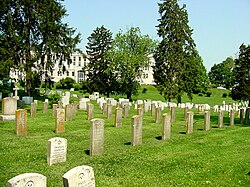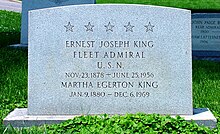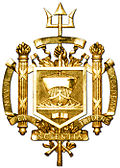In the United States Navy, officers have various ranks. Equivalency between services is by pay grade. United States Navy commissioned officer ranks have two distinct sets of rank insignia: On dress uniform a series of stripes similar to Commonwealth naval ranks are worn; on service khaki, working uniforms, and special uniform situations, the rank insignia are identical to the equivalent rank in the US Marine Corps.

Edward Walter Eberle was an admiral in the United States Navy, who served as Superintendent of the United States Naval Academy and the third Chief of Naval Operations.
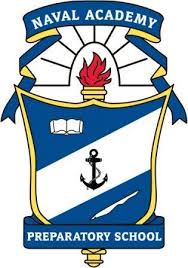
The Naval Academy Preparatory School or NAPS is the preparatory school for the United States Naval Academy (USNA). NAPS is located on Naval Station Newport, Rhode Island. The mission of the Naval Academy Preparatory School is "To enhance Midshipman Candidates' moral, mental, and physical foundations to prepare them for success at the United States Naval Academy".
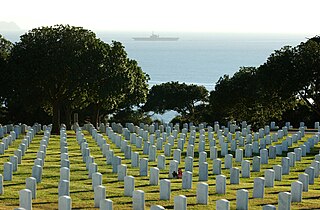
Fort Rosecrans National Cemetery is a federal military cemetery in the city of San Diego, California. It is located on the grounds of the former Army coastal artillery station Fort Rosecrans and is administered by the United States Department of Veterans Affairs. The cemetery is located approximately 10 miles (16 km) west of Downtown San Diego, overlooking San Diego Bay and the city from one side, and the Pacific Ocean on the other. Fort Rosecrans is named after William Starke Rosecrans, a Union general in the American Civil War. The cemetery was registered as California Historical Landmark #55 on December 6, 1932. The cemetery is spread out over 77.5 acres (31.4 ha) located on both sides of Catalina Blvd.
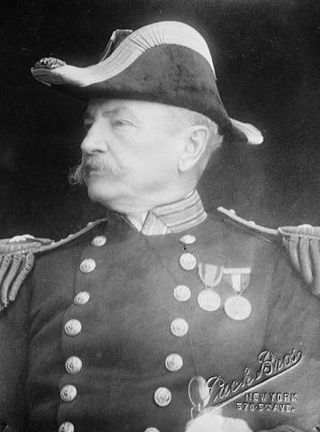
Charles Johnston Badger was an rear admiral in the United States Navy. His active-duty career included service in the Spanish–American War and World War I. From 1919 to 1920 he was vice president, from 1920 to 1921 and 1922 to 1923 president of the Aztec Club of 1847.

John Henry Russell Jr. was a major general and 16th Commandant of the Marine Corps.

Brigadier General Albertus Wright Catlin was a United States Marine Corps general. He also was a recipient of the Medal of Honor for his services during the Occupation of Veracruz in 1914.
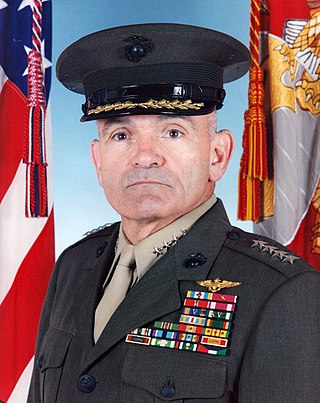
Michael J. Williams is a retired United States Marine Corps 4-star general. He served as Assistant Commandant of the Marine Corps from 2000 until his retirement in 2002.
Hispanics in the United States Naval Academy account for the largest minority group in the institution. According to the academy, the Class of 2009 includes 271 (22.2%) minority midshipmen. Out of these 271 midshipmen, 115 are of Hispanic heritage. In 2004, of the total of 736 female midshipmen, 74 (10%) of them were of Hispanic descent.
A tombstone promotion is an advance in rank awarded at retirement. It is often an honorary promotion that does not include any corresponding increase in retired pay, whose only benefit is the right to be addressed by the higher rank and have it engraved on one's tombstone.

Carl Frederick Holden was a decorated officer in the United States Navy who reached the rank of Vice Admiral. A veteran of both World Wars, he became an expert in Naval communications, graduating with a master's degree in electrical communications from Harvard University. Holden served as Director of Naval Communications between September 1942 - April 1943 and distinguished himself as commanding officer of the battleship USS New Jersey, the flagship of Admiral William F. Halsey. He rose to the admiral's rank in 1945 and commanded Cruiser Division 18 in late phase of the World War II.

Jesse Rink Wallace was a United States Navy Rear admiral and the Governor of American Samoa. He served as governor for a period of only ten days from July 30, 1940, to August 8, 1940. After his brief time as governor, Wallace served with the Office of Judge Advocate General of the Navy until August 1944, when he was ordered to the Pacific Theater as Commanding officer of the Amphibious command ship Eldorado. He led that ship during the Iwo Jima and Okinawa campaigns while serving as flagship of Vice admiral Richmond K. Turner.

John Edward "Ted" Gordon was a retired United States Navy rear admiral who served as Judge Advocate General of the Navy from 1990 until 1992.
The US Navy had four programs for the training of naval aviators.
The Naval Order of the United States was established in 1890 as a hereditary organization in the United States for members of the American sea services. Its primary mission is to encourage research and writing on naval and maritime subjects and preserve documents, portraits, and other records of prominent figures, deeds and memories of American naval and maritime history.

Clayton Barney Vogel was a United States Marine Corps officer with the rank of major general who served in a variety of capacities from 1902 until 1946. He is best known for his support of the Navajo code talker program.
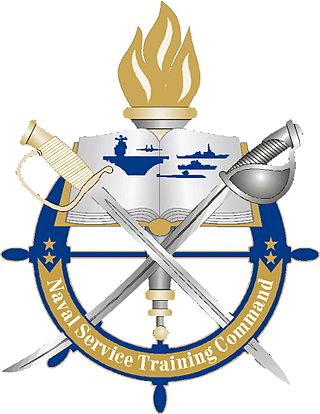
The Naval Service Training Command (NSTC) is a one-star echelon III command of the United States Navy that is responsible to the Chief of Naval Education and Training for the indoctrination and training of all new accessions into the Naval Service, with the exception of Midshipmen who access through the United States Naval Academy. This includes all new recruits through Recruit Training Command, the Navy's only enlisted recruit training location and all Officer "Candidates" who are seeking a commission through the Officer Training Command at Naval Station Newport, Rhode Island. Also under its purview is the operation of the various Naval Reserve Officers Training Corps (NROTC) units in universities across the country. The current NSTC is Rear Admiral Craig T. Mattingly.
Charles Sprague Beightler served in the United States Navy, commanding vessels during World War II in the Pacific, and ultimately achieving the rank of rear admiral.

Hugh McJunkin Elwood was a highly decorated flying ace in the United States Marine Corps during World War II. A veteran of three conflicts, he remained in the Marines and reached the rank of lieutenant general. Elwood completed his career as deputy chief of staff in 1973 after 40 years of service.
